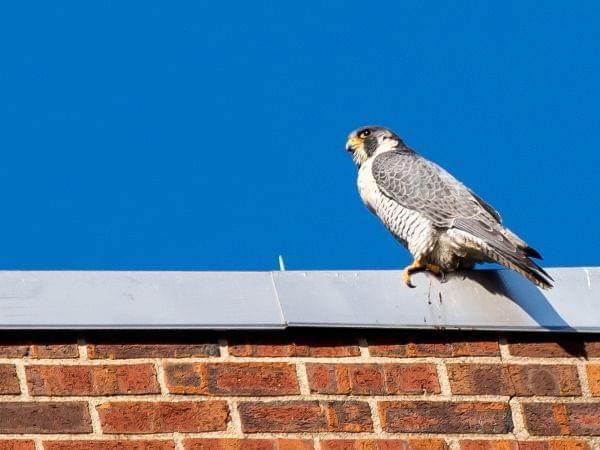Federal policy the foundation for a wildlife success story

A peregrine falcon perched atop the Psychology Building at the University of Illinois. Rob Kanter
In the late winter and early spring, people pay a lot of attention to firsts--when various flowers emerge and bloom, when various birds begin to sing, etc. But it’s also a good time to note departures, which I find much more difficult to track. You know the feeling if you’ve ever looked out in May and wondered, “When did all the juncos disappear?”
In the weeks to come, there’s one particular departure I’m anticipating with a little anxiety, that of a peregrine falcon. The peregrine I refer to has been a regular on the University of Illinois campus for the past decade. It arrives at about the same time the students do each August, and it departs in mid-March, presumably headed north for the breeding season.
While it’s in central Illinois, the peregrine is most easily observed perched high up on tall buildings around the University of Illinois campus. Favored spots include the Illini Tower, Sherman Hall, and the tower on Green Street near Fourth. It also spends a fair bit of time atop the Psychology Building, which is about as near to the ground as you’re likely to see it.
If you want to look for the peregrine yourself before it leaves town, your best bet is to scan the ledges around the top of these buildings in the next couple of weeks. The bird you’re looking for is about 16 inches long from head to tail tip, and there are typically no other birds so big sitting on buildings so high up. While you can see it well enough to know it’s there from some distance, you’ll need binoculars to make out any detail.
In decent light, you can recognize it by its blue-gray back and wings, the dark, helmet-like markings on its head, and the wide lines that extend down over its cheeks like exaggerated sideburns. If you get a look at the peregrine’s front, you will see that it is more heavily marked than the other birds of prey commonly seen in our area, such as red-tailed and Cooper’s hawks.
While the peregrine’s appearance is striking, it’s true claim to fame is speed. Peregrines chasing prey can reach nearly 70 mph in powered flight, a speed rivaled in land animals only by cheetahs and pronghorns. What’s more, peregrines often hunt by circling up high over other birds in flight and then dropping down on them with wings folded against their body in a “stoop” where they may hit 200 mph or more.
I mentioned before that I’m anxious about “our” peregrine leaving this month; that’s because it’s getting pretty old for a bird of prey. Peregrines in the wild may survive 20 years, which is twice as long as ours has been coming back, but the odds of it living to return here decline from one year to the next.
You may or may not be old enough to remember it, but peregrine falcons were among the many species of birds of prey that were nearly eradicated in the lower forty-eight states by pesticide poisoning in the mid twentieth century. Peregrines were able to hang on—and then come back—thanks to the US EPA banning the indiscriminate use of DDT in 1972, and to the intensive recovery program called for by the Endangered Species Act.
Indeed, the peregrine’s removal from the list of threatened and endangered species in 1999, after 30 years on the list, marks one of the most dramatic successes of the Endangered Species Act.
